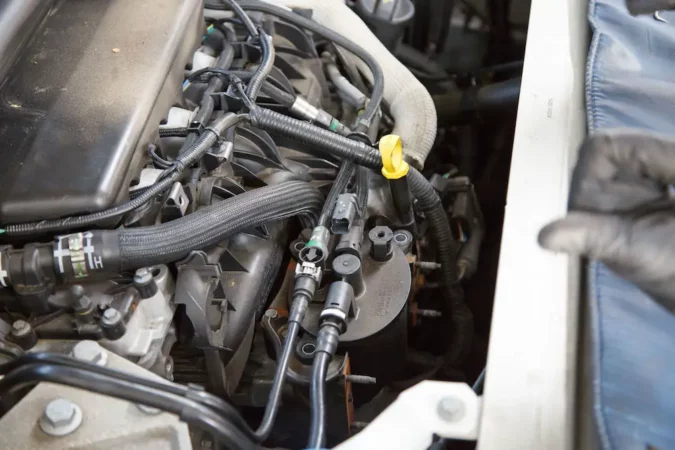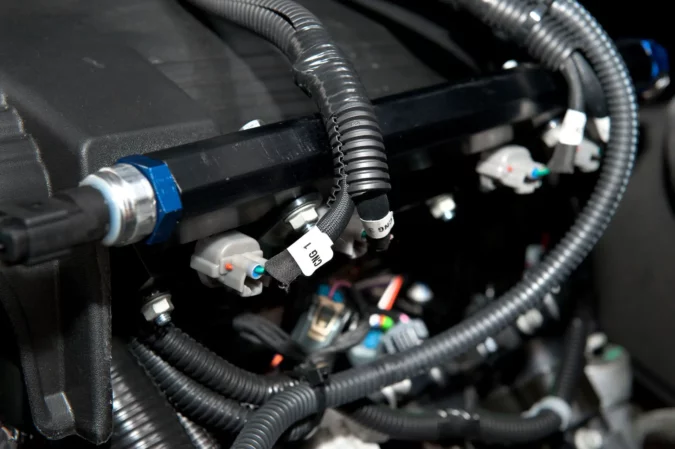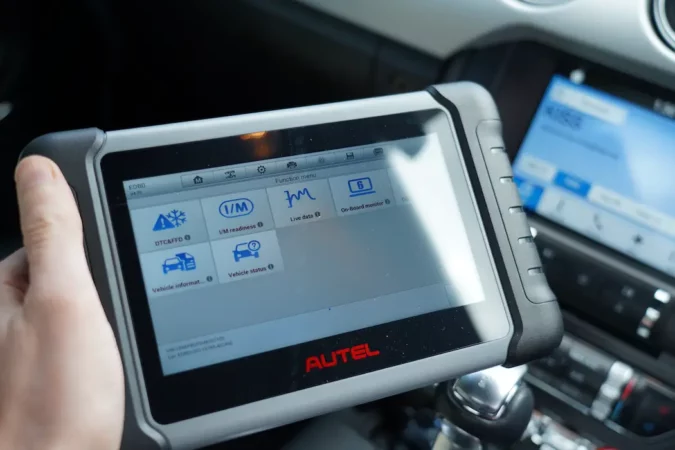The P0442 code Chevy Silverado refers to an evaporative emission control system (EVAP) malfunction. This code indicates that there is a small leak in the EVAP system. This system is responsible for preventing fuel vapors from escaping into the atmosphere.
The EVAP system is designed to capture and store fuel vapors from the fuel tank and then release them back into the engine for combustion. The system uses various sensors and valves to detect and control the flow of these vapors.
When the P0442 code appears, it means that the EVAP system has detected a small leak. This could be caused by a loose or damaged gas cap, a cracked or damaged EVAP hose, a faulty EVAP purge valve, or a damaged EVAP canister.
If you have a Chevy Silverado and see the P0442 code appear on your dashboard, it is important to have the vehicle diagnosed and repaired as soon as possible. Continuing to drive with this code present can result in reduced fuel efficiency. Alongside that, there would be increased emissions, which can be harmful to the environment.
- P0442
- EVAP System Leak
- P0442 Code Chevy Silverado Symptoms
- P0442 Code Chevy Silverado Causes
- Conclusion
- Frequently Asked Questions
P0442
The P0442 code is an important diagnostic code that can appear on a Chevy Silverado. As said before, it indicates that there is a problem with the evaporative emission control system (EVAP). This is responsible for preventing fuel vapors from escaping into the atmosphere.
When this code appears, it is important to address the issue as soon as possible. This is to prevent further damage to the vehicle and reduce the impact on the environment. A small leak in the EVAP system can be caused by several different factors. This includes a loose or damaged gas cap, a cracked or damaged EVAP hose, a faulty EVAP purge valve, or a damaged EVAP canister.
To diagnose the issue, a technician will use a scan tool to retrieve the code. They will then perform a series of tests to determine the source of the problem. One of the most common causes of the P0442 code is a faulty gas cap. A gas cap that is not properly tightened or has a damaged seal can allow fuel vapors to escape from the fuel tank. This will further trigger the code.
Simply replacing the gas cap can often solve the problem. If the issue is not the gas cap, a technician will need to perform additional tests. This will help to identify the source of the leak. This may involve using a smoke machine to detect leaks in the EVAP system. You can also perform a pressure test to check for leaks.
EVAP System Leak
An EVAP system leak is a common issue that can occur in vehicles. The EVAP system is designed to capture and store fuel vapors from the fuel tank. It then releases them back into the engine for combustion. A leak in the EVAP system can result in these fuel vapors escaping into the atmosphere. This will further cause increased emissions and reduced fuel efficiency.
The most common cause of an EVAP system leak is a damaged or loose gas cap. If the gas cap is not tightened properly, it can allow fuel vapors to escape from the fuel tank, triggering a leak in the EVAP system. In this case, simply tightening or replacing the gas cap can often solve the problem.
If not the gas cap, a technician will need to perform additional tests to identify the source of the leak. This may involve using a smoke machine to detect leaks in the EVAP system or performing a pressure test to check for leaks.
Once the source of the leak has been identified, the technician can repair or replace the damaged component. This may involve replacing a damaged EVAP hose or canister, repairing a cracked or damaged component, or replacing a faulty valve.
Besides P0442, you might also notice other EVAP-related OBD codes (that can help you diagnose this issue):
- P0440 code
- P0443 code
- P0446 code (including make-specific ones such as P0446 Toyota or P0446 Chevy)
- P0449 code
- P0455 code
- P0456 code (including make-specific ones such as P0456 Dodge)
- P0457 code
- P0496 code (including make-specific ones such as P0496 Chevy)
P0442 Code Chevy Silverado Symptoms
As said before, the P0442 code is an important diagnostic code that can appear on a Chevy Silverado. It indicates that there is a problem with the evaporative emission control system (EVAP). This system is responsible for preventing fuel vapors from escaping into the atmosphere. Here are some symptoms that you may experience when the P0442 code appears on your Chevy Silverado.
P0442 Code Chevy Silverado Symptoms: Check Engine Light
The Check Engine Light is an important warning indicator that can appear on the dashboard of a vehicle. It is also known as the Malfunction Indicator Lamp (MIL). It is designed to alert drivers to potential problems with the engine or other systems in the vehicle.
When the Check Engine Light appears, it means that the vehicle’s onboard diagnostic system has detected an issue. It then further stores a diagnostic trouble code (DTC) in its memory. Ignoring the Check Engine Light can lead to further damage to the vehicle. It could potentially cause more costly repairs down the road.
It is important to have the vehicle diagnosed by a qualified technician as soon as possible. This is to determine the cause of the issue and make any necessary repairs. Some common causes of the Check Engine Light include issues with the EVAP system, faulty oxygen sensors, and problems with the ignition system or fuel injectors.
P0442 Code Chevy Silverado Symptoms: Reduced Fuel Efficiency
Reduced fuel efficiency is a common symptom that can occur when there is a problem with a vehicle’s engine or other systems. This can be caused by a variety of factors, including issues with the fuel system, ignition system, or transmission. When fuel efficiency is reduced, the vehicle may require more frequent trips to the gas station. This may experience increased fuel costs over time.
Some common causes of reduced fuel efficiency include dirty air filters, worn spark plugs, a faulty oxygen sensor, low tire pressure, and issues with the EVAP system. Regular maintenance, such as changing the air filter and spark plugs, can help improve fuel efficiency.
It will further prevent damage to the vehicle. In addition, ensuring that the tires are properly inflated and avoiding aggressive driving habits can also help improve fuel economy. If you are experiencing reduced fuel efficiency, it is important to have the vehicle diagnosed by a qualified technician.
This is to determine the underlying cause of the issue and make any necessary repairs to improve fuel economy.
P0442 Code Chevy Silverado Symptoms: Fuel Odor
A fuel odor in or around a vehicle can be a concerning issue that requires attention from a qualified technician. This type of odor is usually caused by a leak in the fuel system or an issue with the evaporative emission control system (EVAP).
A fuel leak can occur in several places (as indicated by a P0441 error code), such as the fuel tank, fuel lines, fuel injectors, or even the fuel cap. A damaged or cracked component in the fuel system can allow fuel to leak out, resulting in a strong fuel odor in or around the vehicle.
An issue with the EVAP system can also cause a fuel odor. The EVAP system is responsible for preventing fuel vapors from escaping into the atmosphere. If there is a leak in the EVAP system, fuel vapors can be released and produce a noticeable fuel odor both inside and outside the vehicle.
It is important to address a fuel odor as soon as possible to prevent further damage to the vehicle and ensure safety on the road. A qualified technician can diagnose the source of the odor and make any necessary repairs to prevent further fuel leaks or issues with the EVAP system.
P0442 Code Chevy Silverado Symptoms: Failed Emissions Test
A failed emissions test can be a frustrating experience for vehicle owners. Emissions tests are required in many areas to ensure that vehicles are not producing harmful pollutants. If a vehicle fails an emissions test, it means that it is not meeting the required emissions standards. They may be producing harmful pollutants at a higher level than allowed by law.
There are many reasons why a vehicle may fail an emissions test. Common issues include problems with the EVAP system, faulty oxygen sensors, a malfunctioning catalytic converter, and issues with the ignition system or fuel injectors.
If a vehicle fails an emissions test, it is important to have it diagnosed and repaired by a qualified technician as soon as possible. Ignoring the issue can result in more costly repairs down the road and may even result in fines or penalties for driving a vehicle that is not meeting emissions standards.
By addressing the issue promptly, vehicle owners can ensure that their vehicle is running efficiently and is not contributing to harmful air pollution.
P0442 Code Chevy Silverado Causes
The P0442 code in a Chevy Silverado is typically caused by a leak in the evaporative emission control system (EVAP). The EVAP system is designed to capture fuel vapors from the fuel tank and prevent them from escaping into the atmosphere.
A P0442 code indicates that the system is detecting a small leak in the system, which can be caused by several factors. Some common causes of a P0442 code Chevy Silverado include:
1. Loose Or Damaged Gas Cap
A loose or damaged gas cap is a common cause of the P0442 code in the Chevy Silverado. The gas cap is an important component of the evaporative emission control system (EVAP) and helps to seal the fuel tank and prevent fuel vapors from escaping into the atmosphere. If the gas cap is loose or damaged, it can allow fuel vapors to escape, triggering the P0442 code.
To fix this issue, vehicle owners should check the gas cap to ensure it is tightened securely. If the gas cap is damaged, it should be replaced with a new one. In many cases, tightening or replacing the gas cap can resolve the P0442 code without the need for further repairs. If so, consider a gas cap replacement ASAP.
2. Faulty EVAP Vent Valve Or Purge Valve
The EVAP vent valve and purge valve are important components of the evaporative emission control system (EVAP). The vent valve allows air to enter the fuel tank to replace the fuel that has been consumed. When the purge valve opens to allow fuel vapors to be drawn into the engine and burned.
If either of these valves becomes stuck or fails, it can prevent the EVAP system from functioning properly and can trigger the P0442 code. A qualified technician can diagnose and test these valves to determine if they are functioning properly, and replace them if necessary to resolve the P0442 code.
3. Cracked Or Damaged EVAP Lines
The EVAP lines in a Chevy Silverado are responsible for transporting fuel vapors from the fuel tank to the EVAP canister and the engine. Over time, these lines can become cracked or damaged, which can cause fuel vapors to escape and trigger the P0442 code.
To diagnose this issue, a qualified technician will inspect the EVAP lines for any visible signs of damage or wear. If a damaged line is found, it should be replaced with a new one to restore the integrity of the EVAP system and prevent further fuel vapor leaks. Repairing or replacing the EVAP lines can resolve the P0442 code and ensure that the vehicle is functioning properly.
4. Faulty Charcoal Canister
The charcoal canister in a Chevy Silverado is designed to capture and store fuel vapors from the EVAP system. If the canister becomes saturated or damaged, it may not be able to effectively capture fuel vapors, which can cause fuel vapors to escape and trigger the P0442 code. Solving the symptoms of a bad charcoal canister might require a canister purge valve replacement.
To diagnose this issue, a qualified technician can perform a visual inspection of the charcoal canister and test it for any leaks or damage. If the canister is damaged or not functioning properly, it should be replaced with a new one. Replacing the charcoal canister can help restore the proper functioning of the EVAP system and prevent the P0442 code from reoccurring.
5. How To Fix An EVAP Leak
Fixing an EVAP leak in a Chevy Silverado involves different steps depending on the cause of the leak. Some solutions include:
- Tightening or replacing the gas cap: If the leak is caused by a loose or damaged gas cap, simply tightening or replacing the gas cap may solve the problem.
- Replacing faulty EVAP valves: If the leak is caused by faulty EVAP valves, such as the vent valve or purge valve, they may need to be replaced by a qualified technician.
- Repairing or replacing damaged EVAP lines: If the leak is caused by cracked or damaged EVAP lines, they may need to be repaired or replaced.
- Replacing a faulty charcoal canister: If the leak is caused by a faulty charcoal canister, it may need to be replaced with a new one.
- Smoke testing: In some cases, a smoke test may be performed to help locate the source of the leak.
Conclusion
In conclusion, the P0442 code in a Chevy Silverado indicates a problem with the evaporative emission control system (EVAP). It is designed to capture and store fuel vapors from the fuel tank. It further prevents them from escaping into the atmosphere.
A P0442 code is typically caused by a leak in the system. This leak can be caused by a loose or damaged gas cap, faulty EVAP valves, cracked or damaged EVAP lines, or a faulty charcoal canister. If you are experiencing a P0442 code in your Chevy Silverado, it is important to have the vehicle diagnosed by a qualified technician.
They can help to determine the underlying cause and make any necessary repairs. Fixing the underlying issue can help to restore the proper functioning of the EVAP system. It will furthermore prevent fuel vapors from escaping, and improve the overall performance and fuel efficiency of the vehicle.
Frequently Asked Questions
Here are some common questions relating to the problem,” P0442 Code Chevy Silverado”.
What Is An EVAP Leak
An EVAP (evaporative emission control) leak occurs when there is a fault in the evaporative emission control system of a vehicle. The EVAP system is designed to capture and store fuel vapors that evaporate from the fuel tank. The system includes components such as the fuel tank, fuel lines, charcoal canister, and valves that work together to capture and store fuel vapors. When there is a leak in the EVAP system, it can allow fuel vapors to escape, which can trigger the check engine light and cause the vehicle to fail an emissions test. The most common cause of an EVAP leak is a damaged or loose gas cap, but it can also be caused by faulty valves, damaged or cracked fuel lines, or a malfunctioning charcoal canister. Diagnosing and repairing an EVAP leak is important to prevent fuel vapors from escaping.
How To Test A Gas Cap For Leaks
A damaged gas cap can cause fuel vapors to leak, leading to the check engine light being triggered. This can cause your car to fail emissions tests. Testing a gas cap for leaks involves a simple visual inspection and a pressure test. The visual inspection involves checking the gas cap for any damage. If the gas cap is damaged, it should be replaced immediately. The pressure test involves using a hand-held vacuum pump and a pressure gauge to monitor if the gas cap is sealing properly. If the pressure drops over time. This could indicate a leak in the system, possibly caused by a faulty gas cap. If it fails either test, it should be replaced with a new one to prevent fuel vapor leaks and maintain the integrity of the evaporative emission control system. Regular inspections and testing are essential for preventing emissions from entering the atmosphere.
Where Is The EVAP Canister Located On A 2005 Chevy Silverado
The EVAP canister on a 2005 Chevy Silverado is typically located underneath the vehicle, near the fuel tank. It is secured to the fuel tank, frame, or a nearby bracket with bolts or straps. To find the canister, you can trace the fuel vapor lines from the engine compartment to the rear of the vehicle. The EVAP canister is a black, plastic cylinder-shaped component with hoses and electrical connections attached to it. Its primary function is to store fuel vapors and purge them from the fuel tank and fuel system. If you suspect an issue with the EVAP system on your 2005 Chevy Silverado, it is recommended that you take your vehicle to a professional mechanic for inspection and diagnosis. They will be able to identify the cause of the issue. They can then perform the necessary repairs to ensure that your vehicle operates efficiently.
What Is An EVAP Code
An EVAP code is a diagnostic trouble code. This code is triggered when there is a problem with the evaporative emissions control (EVAP) system in a vehicle. The EVAP system is designed to capture and store fuel vapors from the fuel tank. It further prevents them from escaping into the atmosphere. The system includes various components, such as the gas cap, fuel tank, fuel lines, EVAP canister, purge valve, and sensors. When an issue arises within the EVAP system, the vehicle’s onboard diagnostic system (OBD) will detect the problem and generate an EVAP code. The specific code will indicate which component or system is causing the issue. Issues such as a leak in the EVAP system, a malfunctioning valve, or a faulty sensor. Once the problem is identified, repairs can be made to restore the proper functioning of the EVAP system. This will prevent harmful emissions from entering the environment.
How To Erase Code P0442
To erase code P0442 from your Chevy Silverado, you will need an OBD-II scan tool or code reader. The OBD-II port is usually located under the dashboard on the driver’s side of the vehicle. First, connect the scan tool or code reader to the OBD-II port and turn on the ignition and the tool. Next, select the Erase Codes option from the main menu of the scan tool. Follow the prompts on the screen to confirm that you want to erase the codes. Wait for the tool to complete the process, which may take a few seconds. Finally, turn off the ignition and disconnect the scan tool or code reader from the OBD-II port.




